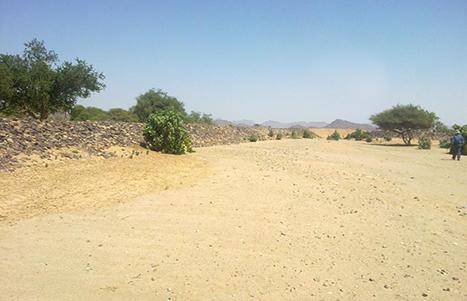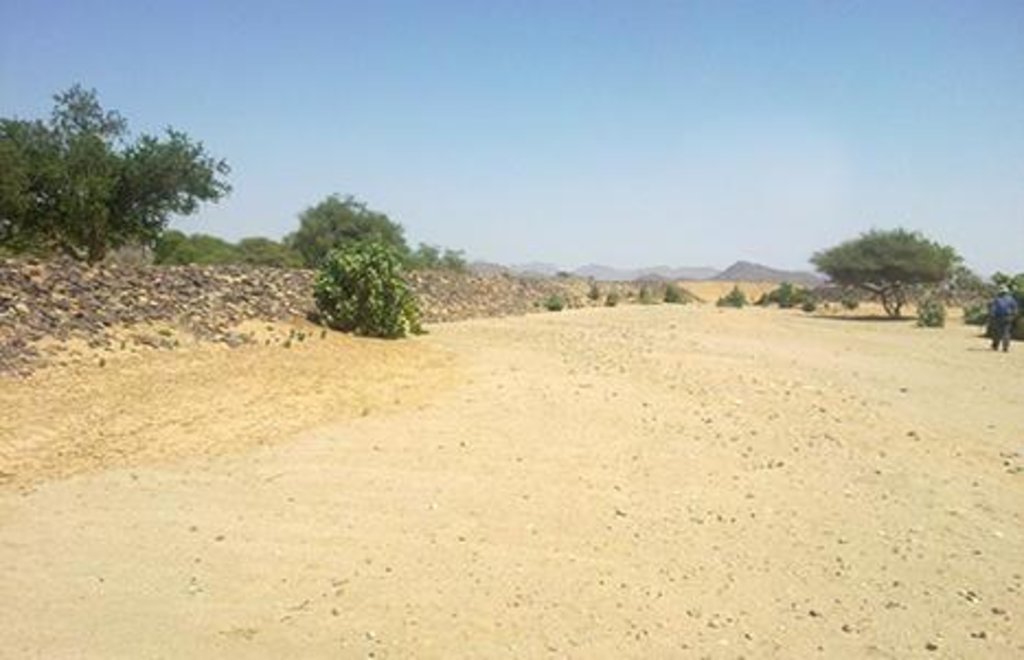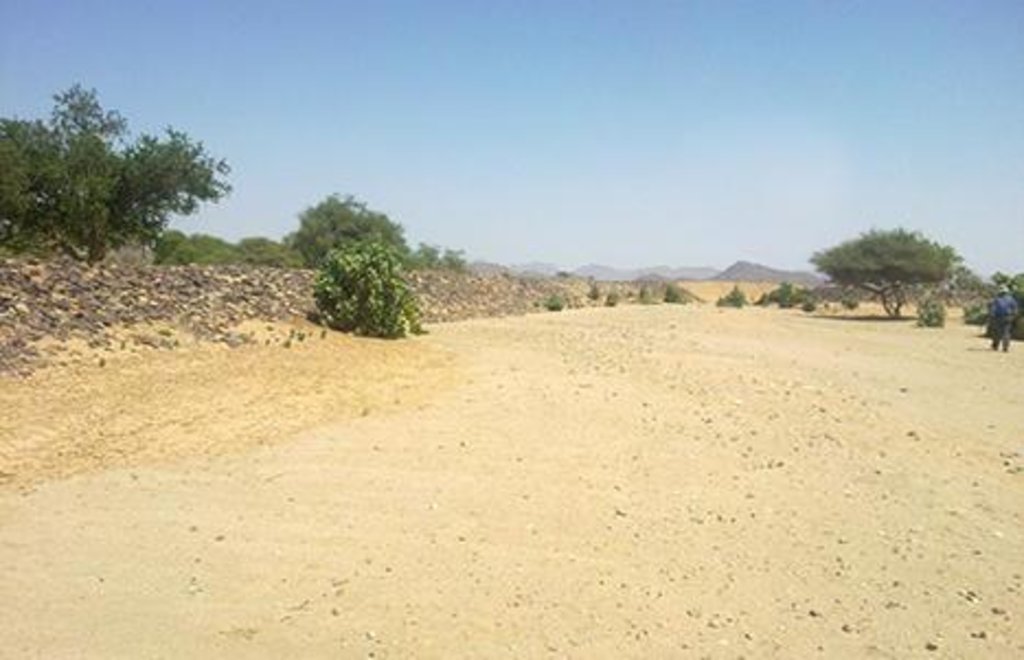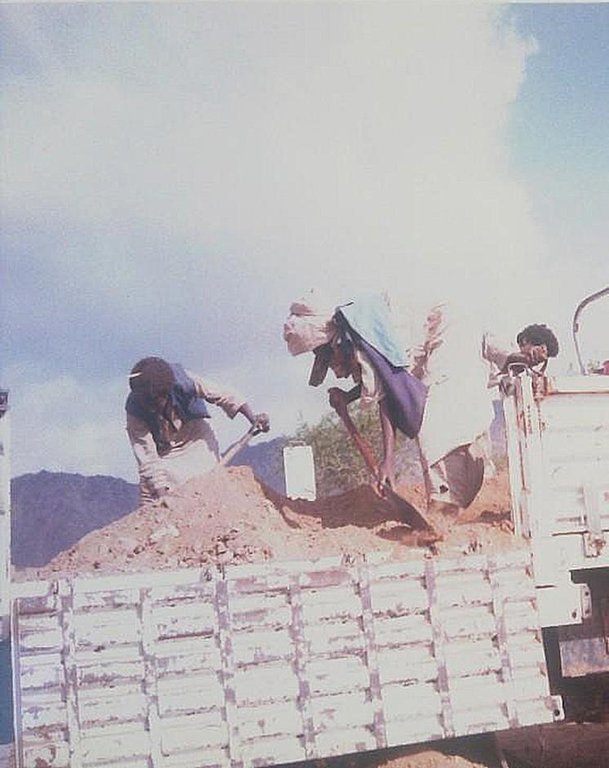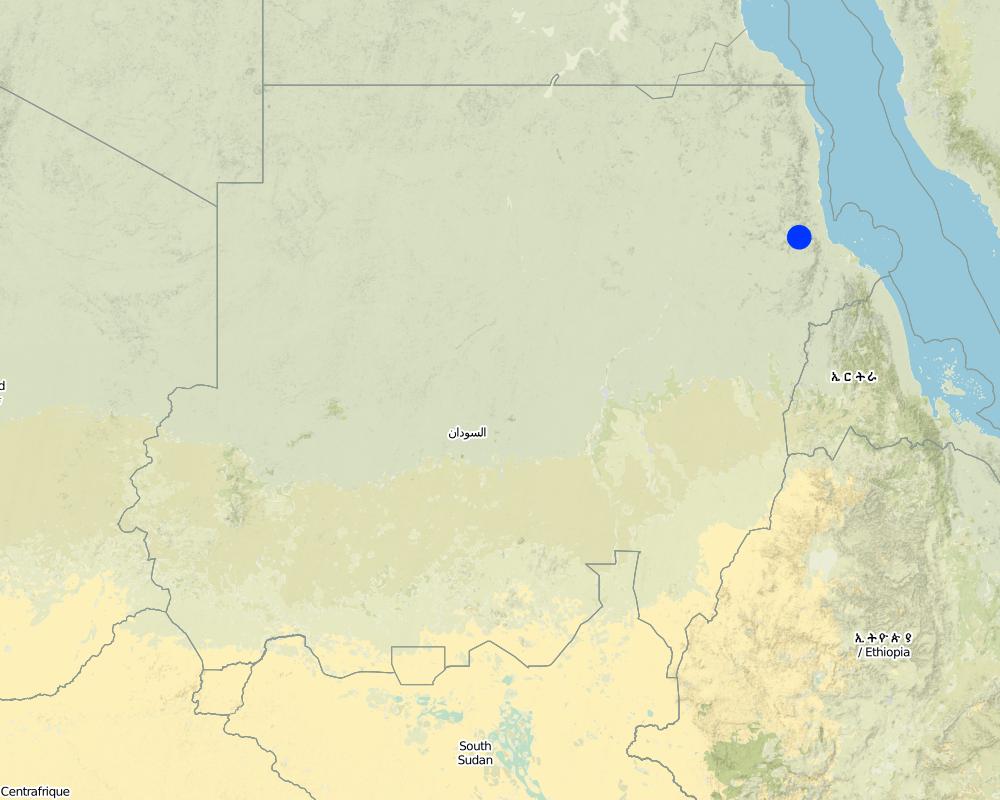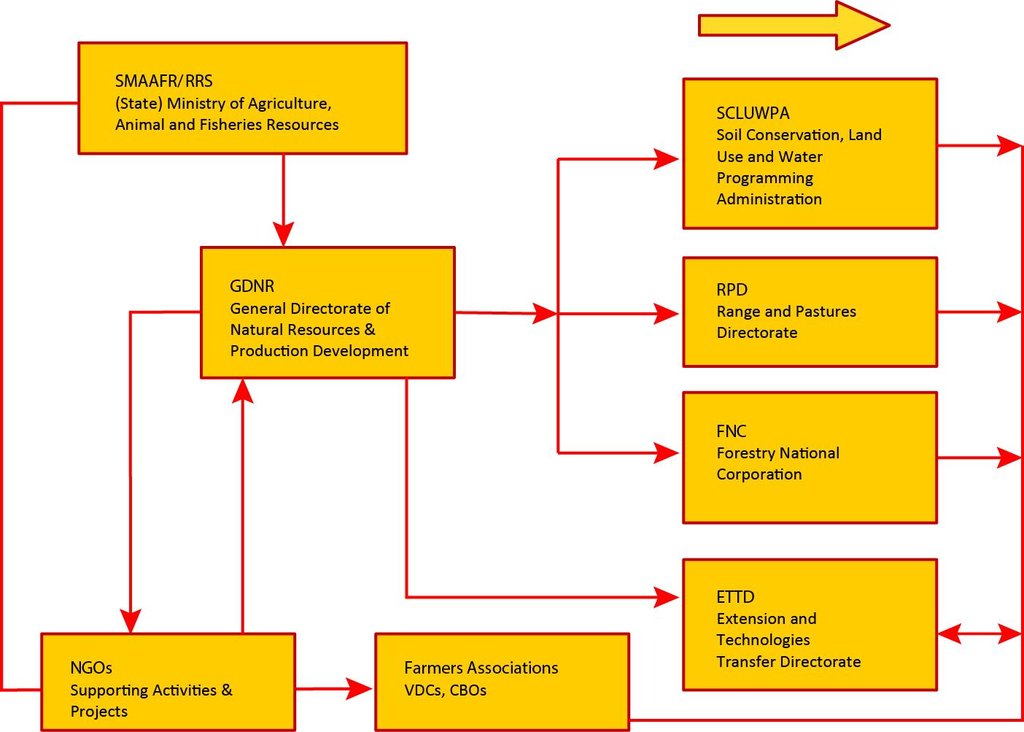Water Spreading (typical example from Hashatribab) [ซูดาน]
- ผู้สร้างสรรค์:
- การอัพเดท:
- ผู้รวบรวม: Abdalla Osman Eisa
- ผู้เรียบเรียง: –
- ผู้ตรวจสอบ: David Streiff
Sidud (Local Arabic) - Tarrit (Beja dialect) for earth dams
approaches_2543 - ซูดาน
ดูส่วนย่อย
ขยายทั้งหมด ย่อทั้งหมด1. ข้อมูลทั่วไป
1.2 รายละเอียดที่ติดต่อได้ของผู้รวบรวมและองค์กรที่เกี่ยวข้องในการประเมินและการจัดเตรียมทำเอกสารของแนวทาง
ผู้เชี่ยวชาญ SLM:
ผู้เชี่ยวชาญ SLM:
Gaiballa Abdelaziz
gaiballa@gmail.com
Sudan University of Science and Technology
ซูดาน
ผู้เชี่ยวชาญ SLM:
Dabaloub Sayed
+249 912913623
dabaloub@gmail.com
SCLUWPA Dirctor (1986-1995), now the ECDP Centre
Port Sudan
ซูดาน
ชื่อของโครงการซึ่งอำนวยความสะดวกในการทำเอกสารหรือการประเมินแนวทาง (ถ้าเกี่ยวข้อง)
Soil Conservation, Land Use and Water Adminstratio (Soil Conservation, Land Use and Water Adminstratio) - ซูดานชื่อของโครงการซึ่งอำนวยความสะดวกในการทำเอกสารหรือการประเมินแนวทาง (ถ้าเกี่ยวข้อง)
VU University Amsterdam (VU University Amsterdam) - เนเธอร์แลนด์ชื่อของโครงการซึ่งอำนวยความสะดวกในการทำเอกสารหรือการประเมินแนวทาง (ถ้าเกี่ยวข้อง)
Sudan University of Science and Technology (SUST) - ซูดาน1.3 เงื่อนไขที่เกี่ยวข้องกับการใช้ข้อมูลที่ได้บันทึกไว้ผ่านทาง WOCAT
วันที่เก็บรวบรวมข้อมูล (ภาคสนาม):
15/05/2012
ผู้รวบรวมและวิทยากรหลักยอมรับเงื่อนไขเกี่ยวกับการใช้ข้อมูลที่ถูกบันทึกผ่านทาง WOCAT:
ใช่
1.4 การอ้างอิงถึงแบบสอบถามเรื่องเทคโนโลยี SLM
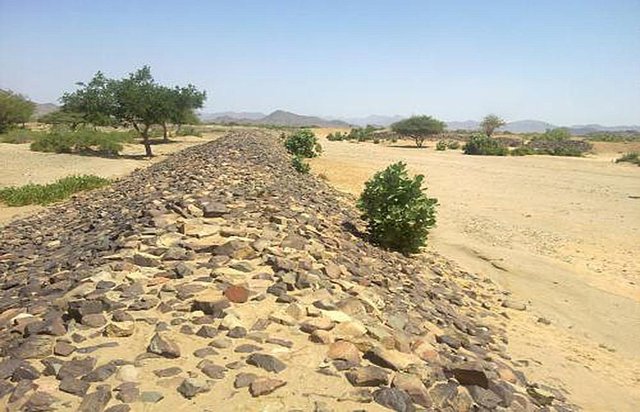
Water Spreading (typical example from Hashatribab) [ซูดาน]
Water Spreading (or Spate Irrigation system) conducted through the construction of earth dam structures at the khor cross section.
- ผู้รวบรวม: Abdalla Osman Eisa
2. คำอธิบายของแนวทาง SLM
2.1 การอธิบายแบบสั้น ๆ ของแนวทาง
Construction of water spreading system on khor and wadi with machinery jointly government and farmers in dam compaction and pitching.
2.2 การอธิบายอย่างละเอียดของแนวทาง
การอธิบายอย่างละเอียดของแนวทาง:
Aims / objectives: The main objective of the approach is to enable domestic land users cultivating crops (sorghum mainly) on a flood plain through construction of an earthen, stone-pitched barrier across the bed of a khor (stream). This earth dam serves to divert floodwaters onto their fields downstream. The approach is fully subsidized as the government provide technician and machines for the construction. Only some voluntary contribution from the beneficiaries is needed (for stone pitching). However maintenance support by the government is not provided later on.
This case study is typical of all those in the State. All are demand-driven...In addition the government supports farmers in rural extension e.g. preparedness, awareness, organization and mobilization, and to establish farmers VDCs (Village Development Committee) to guide the community in public works. Training and capacity building sessions in cultural extension are hold to develop crop raising techniques. The aim behind this is mainly to fill the gap of people’s deficiency in storage of crops such as sorghum and millet to maintain food security in the region.
Methods: 1/ Earth dam and terraces construction for water diversion and spreading.
2/ Agronomic measures e.g. ploughing, levelling, furrowing etc. to raise the soil to its maximum capacity.
3/ Provision of certified seeds: Varieties of short mature period and of drought resistance.
4/ Provision of special hand tools for weeding to maintain soil moistures and sustain the growing of crops.
5/ Development of mixed crop systems by provision of cash crop to support the rural economy.
Stages of implementation: 1. Identify and prioritize the needs of local beneficiaries according to their land size, social and economic situation, the local soil types, the cultivated indigenous crops etc.
2. To reach mutual partnership between Government and local communities a certain number of beneficiaries of the community is dedicated to contribute to volunteer manual work.
3. Based on peoples previous natural environment experience the location of the dam is to be examined and an engineering map has to be set out. That means people’s involvement from the very beginning of the project for planning, design and implementation.
4. For construction the government provides necessary needed machines.
5. The local community should mainly ensure the maintenance and the clearing out of the land for smooth water flow.
Role of stakeholders: Division of labor between the stockholders so as to identify the role
1- Land owners: piece of land.
2- Farmers: farming activities.
3- Ministry of Agriculture (MoA): provide machinery and technical support.
4- SLM specialist: will give the technical advice.
Other important information: Floodwater now takes way to any lower area and creates a new water course.
After several years soil should be tilled by ploughing, planking and furrowing to increase water infiltration and percolation as over the years the accumulated silt turns the soils nearly impermeable.
Finally some types of soil in the Red Sea State become very fertile and rich and do not need chemical or organic fertilizers anymore.
2.3 รูปภาพของแนวทาง
2.5 ประเทศ ภูมิภาค หรือสถานที่ตั้งที่ได้นำแนวทางไปใช้
ประเทศ:
ซูดาน
ภูมิภาค/รัฐ/จังหวัด: :
Red Sea State
ข้อมูลเฉพาะเพิ่มเติมของสถานที่ตั้ง:
Sinkat Locality
ความคิดเห็น:
This covers the case study of Hashtribab water spreading scheme as documented in the associated QT though is an approach used all over the State. e.g. Erkawit.
Map
×2.6 วันที่เริ่มต้นและสิ้นสุดของแนวทาง
ระบุปีที่เริ่ม:
1970
2.7 ประเภทของแนวทาง
- ใช้โครงงานหรือแผนงานเป็นฐาน
2.8 เป้าหมายหรือวัตถุประสงค์หลักของแนวทาง
The Approach focused mainly on SLM with other activities (Rehabilitation of natural resources and agriculture for improving soil conditions and fertility. )
To overcome the inability of poor farmers to invest in durable water harvesting schemes and (later; in the 1990s and onwards) to take over the implementational role from NGOs and donors. They could continue to invest but they should be stopped to be concernde with implementation as they were in the 1970s and 1980s
The SLM Approach addressed the following problems: Lack of water to grow crops, lack of money for farmers to invest in infrastructure.
2.9 เงื่อนไขที่เอื้ออำนวยหรือเป็นอุปสรรคต่อการนำเทคโนโลยีภายใต้แนวทางนี้ไปปฏิบัติใช้
บรรทัดฐานและค่านิยมทางสังคม วัฒนธรรม ศาสนา
- เป็นอุปสรรค
Lack of machinery and money to construct durable schemes
Treatment through the SLM Approach: Assistance from Government
การมีไว้ให้หรือการเข้าถึงแหล่งการเงินและบริการ
- เป็นอุปสรรค
1/Limited resources specially in the infrastructure of the concerned government departments
2/ Low capacity of the traditionally adopted technology as well as at farmers communities level.
3/ Limited financial resources especially of extension and capacity building and training at grass root level as well as at staff level
Treatment through the SLM Approach: 1/ Raise the capacity of the technology used
2/ intensive training of both cultural, and rural extension
3/ Training in water harvesting techniques for traditional farmers and in reclamation methods in water management
4/ Encourage farmers innovations and initiatives based on community based approaches for land use management
การจัดตั้งระดับองค์กร
- เป็นอุปสรรค
1/ At community level VDCs has low capacity in community organization
2/ Follow up and monitoring is very limited and at an adhoc bases where as carried on occasionally
3/ serious problem as related to water spreading and diversions usually vulnerable to breakage and washed out. The miss located sites of earth dam constriction is the main factor behind
Treatment through the SLM Approach: Raising the capacity of Gov. Dept. in extension techniques and the most develop water harvesting methods
กรอบแนวทางในการดำเนินการด้านกฎหมาย (การถือครองที่ดิน สิทธิในการใช้ที่ดินและน้ำ)
- เป็นอุปสรรค
Some conflicts on some areas arise
Treatment through the SLM Approach: Negotiation between parties / stakeholders under their traditional leadership (tribal)
ความรู้เกี่ยวกับ SLM การเข้าถึงการสนับสนุนด้านเทคนิค
- เป็นอุปสรรค
Lack of technical training
Treatment through the SLM Approach: Fund for training should be available
ปริมาณงานที่ทำได้ กำลังคนที่มีให้
- เป็นอุปสรรค
partnership between different partners with less extent of homogeneity and commitment.
Treatment through the SLM Approach: strength the linkage between different partners in the targeted activities.
อื่นๆ
- เป็นอุปสรรค
Wage differences between NGO staff and government employees
Treatment through the SLM Approach: Top-up payment to government employees
3. การมีส่วนร่วมและบทบาทของผู้มีส่วนได้ส่วนเสียที่เกี่ยวข้อง
3.1 ผู้มีส่วนได้ส่วนเสียที่เกี่ยวข้องในแนวทางนี้และบทบาท
- ผู้ใช้ที่ดินระดับท้องถิ่นหรือชุมชนระดับท้องถิ่น
Farmers with VDCs and individuals.
The adult (40 years) and youth (20 – 30 years). Rarely it has be taken by women
It can be said that the whole community is economically disadvantaged
Men predominant in meeting and negotiations. This were conducted through the VDC's and community elected community board.
- ผู้เชี่ยวชาญ SLM หรือที่ปรึกษาการเกษตร
Extension agents
- องค์กรพัฒนาเอกชน
- รัฐบาลแห่งชาติ (ผู้วางแผน ผู้ทำการตัดสินใจ)
Soil Conservation Department (SCLUWPA) (named differently in different parts of the country), Range and Pastures and Forestry Dirctorates
Community leaders (tribal), Localities assembly, VDCs, Community representatives and Ministers at State level
3.2 การเกี่ยวข้องของผู้ใช้ที่ดินระดับท้องถิ่นหรือชุมชนระดับท้องถิ่นในช่วงต่างๆของแนวทาง
| ความเกี่ยวข้องของผู้ใช้ที่ดินระดับท้องถิ่นหรือชุมชนระดับท้องถิ่น | ระบุผู้ที่มีส่วนเกี่ยวข้องและอธิบายกิจกรรม | |
|---|---|---|
| การริเริ่มหรือการจูงใจ | ระดมกำลังด้วยตนเอง | Demand-driven |
| การวางแผน | ปฏิสัมพันธ์ | Together with specialists |
| การดำเนินการ | ปฏิสัมพันธ์ | Some subsidized labour and in some cases volonteer labours |
| การติดตามตรวจสอบหรือการประเมินผล | ไม่มี | None |
| Research | ไม่มี | Some information provided |
3.3 แผนผังแสดงขั้นตอนการทำงาน (ถ้ามี)
คำอธิบาย:
Institutional framework: Stakeholders and their roles: cross-disciplinary linkages between SMAAFR, collaborating institutions and farmers.
ผู้เขียน:
Abdalla Osman Eisa (Soil Conservation and Land Use Admin. Red Sea State, Sudan)
3.4 การตัดสินใจเลือกใช้เทคโนโลยี SLM
ระบุผู้ที่ทำการตัดสินใจเลือกเทคโนโลยีมากกว่าหนึ่งวิธีไปปฏิบัติใช้:
- ผู้ใช้ที่ดินเป็นผู้ตัดสินใจหลัก โดยการสนับสนุนจากผู้เชี่ยวชาญ SLM
การอธิบาย:
Most of the schemes (of which Hashatribab is a good example) began as a traditional water spreading schemes. Thus the Government built upon the traditionally adopted farmer's technology and developed it my means of improved soil and crop management knowledges and capacity bulding to farmers.
Decisions on the method of implementing the SLM Technology were made by mainly by SLM specialists with consultation of land users. The machinery necessary was in the hands of the Government and the specialists knew what was possible and how it could be done. But for all the land users were consulted.
To develop the traditionally adopted technology it is in the hand of the people themselves and need to be supported by the government. Such technology men are dealing with the natural resources, preventing tree cutting, moving regularly for grazing governance to recover ranges etc. and also they need hand tools awareness techniques.
4. การสนับสนุนด้านเทคนิค การสร้างขีดความสามารถ และการจัดการด้านความรู้
4.1 การสร้างขีดความสามารถ / การอบรม
ได้มีการจัดอบรมให้แก่ผู้ใช้ที่ดินหรือผู้มีส่วนได้ส่วนเสียคนอื่น ๆ หรือไม่:
ใช่
ให้ระบุว่าใครเป็นผู้ได้รับการอบรม:
- ผู้ใช้ที่ดิน
- เจ้าหน้าที่ภาคสนาม / ที่ปรึกษา
- other related goverment Departments
ถ้าเกี่ยวข้อง ให้ระบุ เพศ อายุ สถานภาพ ชาติพันธุ์ เป็นต้น:
on gender basis.
รูปแบบการอบรม:
- เกษตรกรกับเกษตรกร
- จัดการประชุมสู่สาธารณชน
หัวข้อที่พูด:
Rural extension as community organization, public work methods, extension and awareness services
4.2 การบริการให้คำแนะนำ
ผู้ใช้ที่ดินมีการเข้าถึงการรับบริการให้คำปรึกษาหรือไม่:
ใช่
ระบุว่ามีบริการให้คำปรึกษาหรือไม่:
- ไปเยี่ยมชมสถานที่
การอธิบาย/แสดงความคิดเห็น:
Conventional extension; Key elements: 1.Visits, 2.Training, 3.Practice and training by doing ; Cross visits are very important to improve the technical know how and to learn by experience. The practical training is very useful and effective rather to the theoretical one.
Advisory service is quite adequate to ensure the continuation of land conservation activities; Yes, in terms of technical know how but not in terms of adequate resources
4.3 การเสริมความแข็งแกร่งให้กับสถาบัน (การพัฒนาองค์กร)
สถาบันได้รับการจัดตั้งขึ้นมาหรือเสริมความแข็งแกร่งโดยแนวทางนี้หรือไม่:
- ใช่ เล็กน้อย
ระบุระดับของสถาบันที่ได้รับการเสริมความแข็งแกร่งหรือจัดตั้งขึ้นมา:
- ท้องถิ่น
- man power
ให้รายละเอียดเพิ่มเติม :
Because the local institution was involved in negotiations with the Government and also organizing communities; mobilization and awareness. SCLUWPA activities are mainly oriented to conserve soil and vegetation. They tend to clarify land according to the amount of Khor floods into land for agriculture and the land of forests and ranges. This practice is carried on down streams of seasonal rivers while is not specifically going in plains which in need to be reclaimed to reduce sand dunes formation and desert like conditions
4.4 การติดตามตรวจสอบและประเมินผล
การติดตามตรวจสอบและประเมินผลเป็นส่วนหนึ่งของแนวทางหรือไม่:
ใช่
ความคิดเห็น:
There were no changes in the Approach as a result of monitoring and evaluation: Not relevant as no monitoring took place. Only monitoring and evaluation is carried on by SCLUWPA for its activities in earth dams' construction and terraces to speed water. Usually this takes places after and within the period of flooding in addition to sea wall, effectively these devices functioned and finally to trace the impact and the outcome.
There were no changes in the Technology as a result of monitoring and evaluation: as above. In purpose of to check what have done to do some amendments.
4.5 การวิจัย
การวิจัยเป็นส่วนหนึ่งของแนวทางหรือไม่:
ใช่
ระบุหัวข้อเรื่อง:
- นิเวศวิทยา
5. การสนับสนุนด้านการเงินและวัสดุอุปกรณ์
5.1 ระบุงบประมาณประจำปีสำหรับแนวทาง SLM นี้
ถ้าหากว่างบประมาณประจำปีไม่เป็นที่ทราบแน่นอน ให้ระบุช่วงลงไป:
- 2,000-10,000
แสดงความคิดเห็น (แหล่งของการระดมทุน ผู้บริจาคคนสำคัญ):
Approach costs were met by the following donors: international (Training, capacity building and assistance of equipment.): 30.0%; government (Technical staff, equipment and agricultural inputs.): 60.0%; local community / land user(s) (Volunteer man power): 10.0%
5.2 การสนับสนุนด้านการเงิน / วัสดุอุปกรณ์ให้แก่ผู้ใช้ที่ดิน
ผู้ใช้ที่ดินได้รับการสนับสนุนด้านการเงิน / วัสดุอุปกรณ์ไปปฏิบัติใช้เทคโนโลยีหรือไม่:
ใช่
ถ้าใช่ ให้ระบุประเภทของการสนับสนุน เงื่อนไขและผู้จัดหามาให้:
By Government either directly or from donor sources. SCLUWPA, Range and Pastures, UNDP and UNISCO supporting desertification.
5.3 เงินสนับสนุนสำหรับปัจจัยนำเข้า (รวมถึงแรงงาน)
- อุปกรณ์
| ระบุปัจจัยนำเข้าที่ได้รับการสนับสนุน | เห็นด้วยระดับไหน | ระบุเงินสนับสนุน |
|---|---|---|
| เครื่องมือ | ได้รับการช่วยเหลือทางการเงินแบบเต็ม | |
- การเกษตร
| ระบุปัจจัยนำเข้าที่ได้รับการสนับสนุน | เห็นด้วยระดับไหน | ระบุเงินสนับสนุน |
|---|---|---|
| เมล็ด | ได้รับการช่วยเหลือทางการเงินแบบเต็ม | |
- วัสดุสำหรับการก่อสร้าง
| ระบุปัจจัยนำเข้าที่ได้รับการสนับสนุน | เห็นด้วยระดับไหน | ระบุเงินสนับสนุน |
|---|---|---|
| หิน | ได้รับการช่วยเหลือทางการเงินบางส่วน | partial community contribution |
| ไม้ | ได้รับการช่วยเหลือทางการเงินบางส่วน | partial community contribution |
ถ้าแรงงานโดยผู้ใช้ที่ดินเป็นปัจจัยนำเข้าที่มีอยู่มากมาย ระบุด้วยว่าเนื่องจาก:
- สมัครใจ
ความคิดเห็น:
see QT
Only machinery financed for construction period and maintenance.
Labour appears in all mentioned forms above. But voluntarely and food for work is most common.
5.4 เครดิต
มีการจัดหาเครดิตมาให้ภายใต้แนวทาง SLM หรือไม่:
ไม่ใช่
6. การวิเคราะห์ผลกระทบและการสรุป
6.1 ผลกระทบของแนวทาง
ช่วยให้ผู้ใช้ที่ดินนำเอาเทคโนโลยี SLMไปใช้และบำรุงรักษาสภาพไว้ได้หรือไม่:
- ไม่ใช่
- ใช่ เล็กน้อย
- ใช่ ปานกลาง
- ใช่ อย่างมาก
They were able to make the land directly more productive because of the extra water. Furthermore it helped land users in raising their technical know how.
ทำให้กลุ่มด้อยโอกาสมีอำนาจทางสังคมและเศรษฐกิจหรือไม่:
- ไม่ใช่
- ใช่ เล็กน้อย
- ใช่ ปานกลาง
- ใช่ อย่างมาก
Yes, as the whole community was economically disadvantaged
ปรับปรุงประเด็นของการถือครองที่ดินหรือสิทธิในการใช้ ซึ่งขัดขวางการนำเทคโนโลยีไปใช้ให้ดีขึ้น:
- ไม่ใช่
- ใช่ เล็กน้อย
- ใช่ ปานกลาง
- ใช่ อย่างมาก
no problems related to that issue of land rights and ownership and early can be recognized by tribal leadership. The problem is likely to be overcome in the near future. within the tribal system it can be solved any problems on land in cases of difficulties the leadership take decision to be used by all members.
Did other land users / projects adopt the Approach?
- ไม่ใช่
- ใช่ เล็กน้อย
- ใช่ ปานกลาง
- ใช่ อย่างมาก
Not relevant as it is a government driven system. The newly introduced technology is to improve before it can be adopted by other land users.
Did the Approach lead to improved livelihoods / human well-being?
- ไม่ใช่
- ใช่ เล็กน้อย
- ใช่ ปานกลาง
- ใช่ อย่างมาก
Yes, because of extra food supply – though not as dramatic as with irrigation By using simple technology e.g. the hand tools and ohter manually applicable implements can be used easily by land users.
Did the Approach help to alleviate poverty?
- ไม่ใช่
- ใช่ เล็กน้อย
- ใช่ ปานกลาง
- ใช่ อย่างมาก
In terms of food security: but differs from season to season If support subsistence farmers to produce crop and animal herders to multiply animal numbers.
6.2 แรงจูงใจหลักของผู้ใช้ที่ดินเพื่อที่จะนำ SLM ไปปฏิบัติใช้
- การผลิตที่เพิ่มขึ้น
The primary motivation
- well-being and livelihoods improvement
Also very important
6.3 ความยั่งยืนของกิจกรรมของแนวทาง
ผู้ใช้ที่ดินสามารถทำให้สิ่งต่างๆ ที่ได้ปฏิบัติใช้โดยแนวทางนี้ยั่งยืนได้หรือไม่ (โดยไม่มีการสนับสนุนจากภายนอก):
- ไม่
ถ้าตอบว่าไม่หรือไม่แน่ใจ ให้ระบุและแสดงความคิดเห็น :
The land users can continue to crop and to maintain structures within their ability, but no expansion would be possible or repairs to major breakages, unless the level of surplus production will be reached.
6.4 จุดแข็งและข้อได้เปรียบของแนวทาง
| จุดแข็ง / ข้อได้เปรียบของแนวทางในทัศนคติของผู้ใช้ที่ดิน |
|---|
|
1) Improve the socioeconomic situation. 2) Learning and improve their technical capacity. 3) Raising the community awareness and preparedness. 4) Encourage peoples to be involved in collective action. 5) Enhance their capacity of community effective. Management resources (How to sustain/ enhance this strength: -Building and strengthening the establishment of the community institutions i.e. from VDCs to local Community Base Organization CBos national NGos.) |
| จุดแข็ง / ข้อได้เปรียบของแนวทางในทัศนคติของผู้รวบรวมหรือวิทยากรหลัก |
|---|
|
1/ Demand driven response to people’s needs. 2/ Reducing the direct in-field role of NGOs. 3/ Progress to create a national Ngo's. 4/ Building the community institution. 5/ Raising the self help and self reliance for sustainable management. (How to sustain/ enhance this strength: 1/ Continue to listen to the people 2/ By making sure the Government continues to play that role effectively 3/Increase funding . ) |
6.5 จุดอ่อน / ข้อเสียเปรียบของแนวทางและวิธีในการแก้ไข
| จุดอ่อน / ข้อเสียเปรียบในทัศนคติของผู้ใช้ที่ดิน | สามารถแก้ไขปัญหาได้อย่างไร |
|---|---|
|
1) Weak economic base at rural areas. 2) Weak community innovation and involvement. 3) Illiteracy and isolated and knowledge of others experiences 4) Low level of the technology used by the people. 5) Poverty and high vulnerability to natural disasters. |
- to increase land productivity. - to develop crop mixing strategy to include cash crops. - enhance and encourage agroforestry approach. |
| จุดอ่อน / ข้อเสียเปรียบในทัศนคติของผู้รวบรวมหรือวิทยากรหลัก | สามารถแก้ไขปัญหาได้อย่างไร |
|---|---|
|
1/ Weak of funds. 2/ Weak of monitoring and evaluation. 3/ Low of documentation and knowledge sharing. 4) Lack of research involvement. It is better to say few or adequate research activity |
1/ More support. 2/ Introduce a clear, simple system. 3/ International community need to make more efforts to assist with these aspects. 4/ Both Government and NGOs need to recognise the potential role of researchers |
7. การอ้างอิงและการเชื่อมต่อ
7.1 วิธีการหรือแหล่งข้อมูล
- ไปเยี่ยมชมภาคสนาม การสำรวจพื้นที่ภาคสนาม
ลิงก์และโมดูล
ขยายทั้งหมด ย่อทั้งหมดลิงก์

Water Spreading (typical example from Hashatribab) [ซูดาน]
Water Spreading (or Spate Irrigation system) conducted through the construction of earth dam structures at the khor cross section.
- ผู้รวบรวม: Abdalla Osman Eisa
โมดูล
ไม่มีโมดูล


